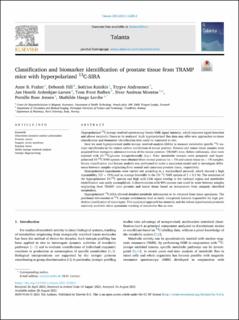| dc.contributor.author | Frahm, Anne | |
| dc.contributor.author | Hill, Deborah Katherine | |
| dc.contributor.author | Katsikis, Sotirios | |
| dc.contributor.author | Andreassen, Trygve | |
| dc.contributor.author | Ardenkjær-Larsen, Jan Henrik | |
| dc.contributor.author | Bathen, Tone Frost | |
| dc.contributor.author | Moestue, Siver Andreas | |
| dc.contributor.author | Jensen, Pernille Rose | |
| dc.contributor.author | Lerche, Mathilde | |
| dc.date.accessioned | 2022-03-04T09:00:15Z | |
| dc.date.available | 2022-03-04T09:00:15Z | |
| dc.date.created | 2021-08-17T12:41:30Z | |
| dc.date.issued | 2021 | |
| dc.identifier.citation | Talanta: The International Journal of Pure and Applied Analytical Chemistry. 2021, 235 1-10. | en_US |
| dc.identifier.issn | 0039-9140 | |
| dc.identifier.uri | https://hdl.handle.net/11250/2983006 | |
| dc.description.abstract | Hyperpolarized 13C isotope resolved spectroscopy boosts NMR signal intensity, which improves signal detection and allows metabolic fluxes to be analyzed. Such hyperpolarized flux data may offer new approaches to tissue classification and biomarker identification that could be translated in vivo.
Here we used hyperpolarized stable isotope resolved analysis (SIRA) to measure metabolite specific 13C isotopic enrichments in the central carbon metabolism of mouse prostate. Prostate and tumor tissue samples were acquired from transgenic adenocarcinomas of the mouse prostate (TRAMP) mice. Before euthanasia, mice were injected with [U–13C]glucose intraperitoneally (i.p.). Polar metabolite extracts were prepared, and hyperpolarized 1D-13C NMR spectra were obtained from normal prostate (n = 19) and cancer tissue (n = 19) samples. Binary classification and feature analysis was performed to make a separation model and to investigate differences between samples originating from normal and cancerous prostate tissue, respectively.
Hyperpolarized experiments were carried out according to a standardized protocol, which showed a high repeatability (CV = 15%) and an average linewidth in the 1D-13C NMR spectra of 2 ± 0.5 Hz. The resolution of the hyperpolarized 1D-13C spectra was high with little signal overlap in the carbonyl region and metabolite identification was easily accomplished. A discrimination with 95% success rate could be made between samples originating from TRAMP mice prostate and tumor tissue based on isotopomers from uniquely identified metabolites.
Hyperpolarized 13C-SIRA allowed detailed metabolic information to be obtained from tissue specimens. The positional information of 13C isotopic enrichments lead to easily interpreted features responsible for high predictive classification of tissue types. This analytical approach has matured, and the robust experimental protocols currently available allow systematic tracking of metabolite flux ex vivo. | en_US |
| dc.language.iso | eng | en_US |
| dc.publisher | Elsevier | en_US |
| dc.rights | Navngivelse 4.0 Internasjonal | * |
| dc.rights.uri | http://creativecommons.org/licenses/by/4.0/deed.no | * |
| dc.title | Classification and biomarker identification of prostate tissue from TRAMP mice with hyperpolarized 13C-SIRA | en_US |
| dc.type | Peer reviewed | en_US |
| dc.type | Journal article | en_US |
| dc.description.version | publishedVersion | en_US |
| dc.source.pagenumber | 1-10 | en_US |
| dc.source.volume | 235 | en_US |
| dc.source.journal | Talanta: The International Journal of Pure and Applied Analytical Chemistry | en_US |
| dc.identifier.doi | 10.1016/j.talanta.2021.122812 | |
| dc.identifier.cristin | 1926611 | |
| cristin.ispublished | false | |
| cristin.fulltext | original | |
| cristin.qualitycode | 1 | |

